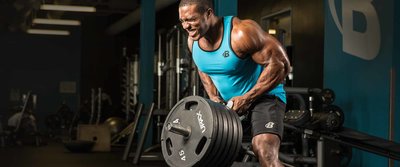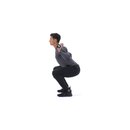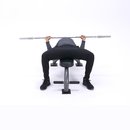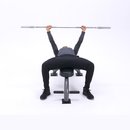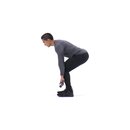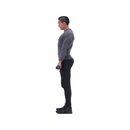You've probably heard, and rightly so, that you can't build muscle without testosterone. Not exactly breaking news, right? But did you know that you may be able to maximize your release of testosterone by making specific choices in the gym? When putting together any workout, some strategies are better than others for naturally boosting T levels—and potentially your muscle growth!
If boosting your test release and building muscle sound good to you, you're in the right place. Stick with me as I briefly geek out on endocrinology, which will provide a fundamental background for understanding why manipulation of certain training stimuli can increase testosterone release.
What Is Testosterone?
Testosterone is an anabolic hormone associated with increasing muscle mass, strength gains, and sex drive. Contrary to what some might think, your muscles don't release testosterone. Testosterone is released from specific cells, called the Leydig cells, located in the testes. Specific regions in your brain—the hypothalamus and anterior pituitary gland—signal the release of testosterone from your testes through a series of hormonal messages.1
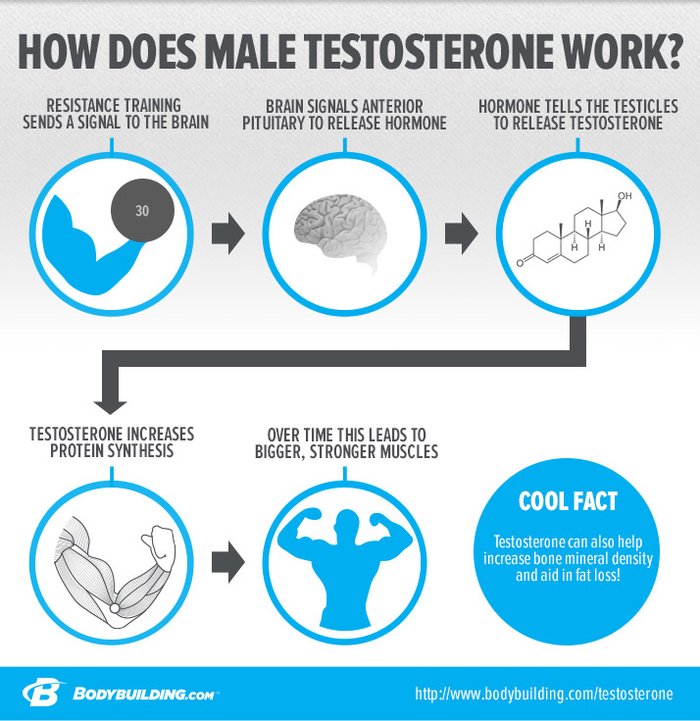
Testosterone is typically found in two forms in the body: free and bound. Free testosterone is the most active form, so it can directly enter into a target (muscle) cell. This is how testosterone can exert anabolic or even anticatabolic actions.
Bound testosterone is attached to sex hormone-binding globulin (SHBG), which blocks the action of testosterone. Some testosterone may also bind to albumin, but this action doesn't inhibit its ability to positively exert anabolic and anticatabolic properties.2,3
The bottom line is, out of all the various types of testosterone, we want to increase our pool of free testosterone in the blood—via lifting weights, and especially in a strategic matter—because testosterone has the ability to increase protein synthesis and muscle mass.
Optimize Your Lifting Program
Let's take a look at a number of training variables that have been measured for their relationship to testosterone release.
1. Intensity
Intensity is best defined as the percentage of your one-rep maximum (1RM). So, if you bench 315 pounds for a one-rep max, and do 225 pounds for reps, you're working at an intensity of about 70 percent.
To optimize your testosterone response, you need to work at a relatively high intensity. When all other factors are held equal, the sessions with the highest overall intensity will result in the greatest testosterone response.
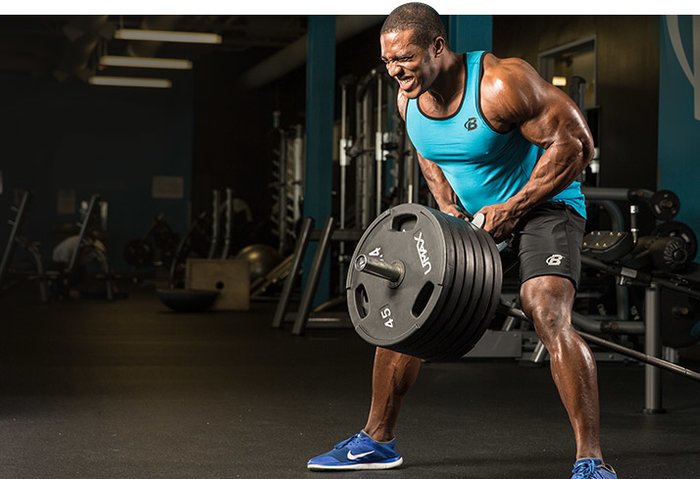
To optimize your testosterone response, you need to work at a relatively high intensity.
In general, research has demonstrated that sets of 3-10 reps, using a relative intensity of 3-10RM, will result in increased testosterone response.2,4,5 Training with singles, or alternately with high reps, seems to be less effective at maximizing T production.
2. Volume
Volume is equal to the total amount of work performed, or sets × reps × intensity. Volume is a somewhat difficult variable to manipulate in the hopes of optimizing testosterone response, in part because there seems to be a point at which greater volume does not mean greater test release.2 In order to hit this threshold, you need to be sure that you're performing a relatively high amount of volume per session.
Loosely interpreted, don't just hitting one-rep maxes all the time. It's ideal to vary your rep ranges between 6-10 and sets between 3-10 per exercise (the high number of sets was completed with a German volume training program). Your total body-part workout should range from 3-6 exercises (doing more exercises if you keep your sets on the low end, and doing fewer exercises if you do more sets, as when following a GVT-type of program).
3. Exercise Choice
Exercise selection is the most important variable you can manipulate when it comes to optimizing testosterone. Without question, the larger the muscle mass involved in a movement, the greater the testosterone response involved.6 Furthermore, the amount of testosterone released is in direct relationship with the amount of muscle mass utilized. This means that a squat will result in a greater release of testosterone than a bench press.7
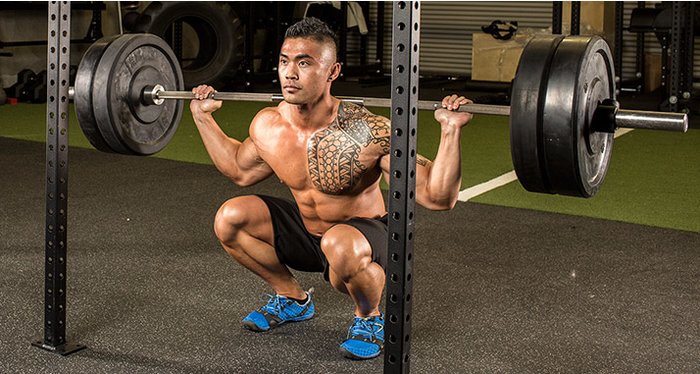
Without question, the larger the muscle mass involved in a movement, the greater the testosterone response involved.
Multijoint exercises—in which more than a single pair of joints are working—are superior to single-joint movements. And because they require more stabilizer activity, free weights are a better choice than machine exercises. When in doubt, choose an exercise that requires a large amount of muscle mass. These could include squat variations, deadlifts, overhead presses, and bench-press variations.
4. Exercise Order
Published research has demonstrated significantly greater increases in testosterone response when multijoint exercises are included in the same session with single-joint exercises targeting smaller muscle groups.8 These same increases in testosterone were associated with a significantly greater increase in strength for the smaller muscle group.
If we aim to satisfy all of the above criteria, it would make sense to put your heavy-hitter, compound exercises first in your session.2 This will ensure an adequate intensity and volume to optimize the rest of your session. Think of it another way: that feeling of almost dying after a solid round of squats can now be seen as bathing your muscles in a bath of testosterone!
5. Rest Periods
As mentioned, acute increases in testosterone have been noted with increases in metabolic demand—that is, working at a higher intensity relative to your 1RM as well as performing a high volume of work. But that's not the only way to increase metabolic demand; another is to shorten the rest periods between sets.2 This would ideally allow for a higher sustained load for the entire session. In fact, increasing rest periods was demonstrated to result in a lesser testosterone release in one study.9

Increasing rest periods was demonstrated to result in a lesser testosterone release in one study.
Currently there's insufficient evidence to determine an exact rest time to optimize testosterone response. But I can almost guarantee you that texting your friends and checking your Instagram profile won't get you any closer to the results you're looking for. If in doubt about rest periods, take just enough time to recover and catch your breath. And make sure the weight on the bar is heavy enough.
Your Own Training!
You're now armed with basic knowledge about how you can boost your testosterone response to exercise. If you follow these methods closely, you'll see gains far superior to those you'd achieve by randomly follow any ol' workout. With that in mind, if your own workout is in need of an upgrade, the following template will give you a great place to start.
This testosterone-boosting training program follows a three-day-a-week split, allowing you to maximize your training intensity while providing enough downtime to keep you mentally fresh. If you want to train more frequently, that's fine. One such variation could entail splitting up the push day into separate shoulder and chest days.
The compound lifts should be a main focus, so strive to really move the bigger weights. Follow this protocol for four weeks and see your strength and muscle gains skyrocket!
Your Test-Boosting Training Plan
- Sets don't include warm-ups sets; do as many as you need but never take warm-up sets to muscle failure.
- Choose a weight so that you reach muscle failure by the target rep. Each set should approach muscle failure except when doing deadlifts; with those use a weight that leaves several reps in the tank.
- Rest 1-2 minutes between sets of all exercises except deadlifts; take two minutes between sets with conventional deadlifts.
- For your active recovery day, walk outside, play basketball, or whatever you enjoy. Choose an activity that gets your body moving while still allowing your muscles to recover.

BodyFit
$6.99/month- 2,500+ expert-created single workouts
- 3,500+ how-to exercise videos
- Detailed workout instruction
- Step-by-step workout tips
- Training at gym or at home
- Access to Workout Plans
- Access to Bodyfit App
- Store Discounts
Already have a Bodybuilding.com account with BodyFit? Sign In

What comes with BodyFit?

- Instructional Videos
Don't risk doing a workout improperly! Avoid injury and keep your form in check with in-depth instructional videos.

- How-to Images
View our enormous library of workout photos and see exactly how each exercise should be done before you give it a shot.

- Step-by-Step Instructions
Quickly read through our step-by-step directions to ensure you're doing each workout correctly the first time, every time.

BodyFit
$6.99/month- 2,500+ expert-created single workouts
- 3,500+ how-to exercise videos
- Detailed workout instruction
- Step-by-step workout tips
- Training at gym or at home
- Access to Workout Plans
- Access to Bodyfit App
- Store Discounts
Already have a Bodybuilding.com account with BodyFit? Sign In

What comes with BodyFit?

- Instructional Videos
Don't risk doing a workout improperly! Avoid injury and keep your form in check with in-depth instructional videos.

- How-to Images
View our enormous library of workout photos and see exactly how each exercise should be done before you give it a shot.

- Step-by-Step Instructions
Quickly read through our step-by-step directions to ensure you're doing each workout correctly the first time, every time.

BodyFit
$6.99/month- 2,500+ expert-created single workouts
- 3,500+ how-to exercise videos
- Detailed workout instruction
- Step-by-step workout tips
- Training at gym or at home
- Access to Workout Plans
- Access to Bodyfit App
- Store Discounts
Already have a Bodybuilding.com account with BodyFit? Sign In

What comes with BodyFit?

- Instructional Videos
Don't risk doing a workout improperly! Avoid injury and keep your form in check with in-depth instructional videos.

- How-to Images
View our enormous library of workout photos and see exactly how each exercise should be done before you give it a shot.

- Step-by-Step Instructions
Quickly read through our step-by-step directions to ensure you're doing each workout correctly the first time, every time.
References
- Kim, H. H., Mui, K. L., Nikrodhanond, A. A., & Tamayo, N. C. (2007, September). Regulation of gonadotropin-releasing hormone in nonhypothalamic tissues. In Seminars in Reproductive Medicine (Vol. 25, No. 5, pp. 326-336).
- Vingren, J. L., Kraemer, W. J., Ratamess, N. A., Anderson, J. M., Volek, J. S., & Maresh, C. M. (2010). Testosterone physiology in resistance exercise and training. Sports Medicine, 40(12), 1037-1053.
- Manni, A., Cefalu, W., Nisula, B. C., Bardin, C. W., Santner, S. J., & Santen, R. J. (1985). Bioavailability of Albumin-Bound Testosterone. The Journal of Clinical Endocrinology & Metabolism, 61(4), 705-710.
- Raastad, T., Bjøro, T., & Hallen, J. (2000). Hormonal responses to high-and moderate-intensity strength exercise. European Journal of Applied Physiology, 82(1-2), 121-128.
- Linnamo, V., Pakarinen, A., Komi, P. V., Kraemer, W. J., & Häkkinen, K. (2005). Acute hormonal responses to submaximal and maximal heavy resistance and explosive exercises in men and women. The Journal of Strength & Conditioning Research, 19(3), 566-571.
- Migiano, M. J., Vingren, J. L., Volek, J. S., Maresh, C. M., Fragala, M. S., Ho, J. Y., ... & Kraemer, W. J. (2010). Endocrine response patterns to acute unilateral and bilateral resistance exercise in men. The Journal of Strength & Conditioning Research, 24(1), 128-134.
- Volek, J. S., Boetes, M., Bush, J. A., Putukian, M., Sebastianelli, W. J., & Kraemer, W. J. (1997). Response of Testosterone and Cortisol Concentrations to High-Intensity Resistance Exercise Following Creatine Supplementation. The Journal of Strength & Conditioning Research, 11(3), 182-187.
- Hansen, S., Kvorning, T., Kjaer, M., & Sjøgaard, G. (2001). The effect of short-term strength training on human skeletal muscle: the importance of physiologically elevated hormone levels. Scandinavian Journal of Medicine & Science in Sports, 11(6), 347-354.
- Kraemer, W. J., Marchitelli, L., Gordon, S. E., Harman, E., Dziados, J. E., Mello, R., ... & Fleck, S. J. (1990). Hormonal and growth factor responses to heavy resistance exercise protocols. Journal of Applied Physiology, 69(4), 1442-1450.


